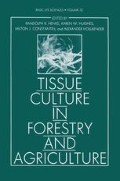Abstract
Conifer tissue culture had its beginnings in the late 1930s (10) and shoot regeneration cultures were first noted in 1950 (4). Since that time many species (7, 17), especially those using embryonic materials for starting expiants, have been cultured. Among some of the most studied species, Pinus radiata (2), Pseudotsuga menziesii (6), Pinus pinaster (8), Picea abies (22), and Pinus taeda (18), much laboratory data are accumulating. To date, little field data have been reported on the performance of tissue-cultured conifers (14), but several conifers are now established in field plantings (21) and data should be forthcoming.
The use of the following trade names throughout this paper does not imply endorsement of these products named, nor criticism of products not named: Captan, Furadan, Peters 15-30-15 and 20-19-18, and RL Super Cells.
Access this chapter
Tax calculation will be finalised at checkout
Purchases are for personal use only
Preview
Unable to display preview. Download preview PDF.
References
Abo El-Nil, M.M. (1982) Method for asexual reproduction of coniferous trees. U.S. Patent No. 4,353,184.
Aitken, J., K.J. Horgan, and T.A. Thorpe (1981) Influence of expiant selection on the shoot-forming capacity of juvenile tissue of Pinus radiata. Can. J. For. Res. 11:112–117.
Amerson, H.V., S.E. McKeand, and R.L. Mott (1981) Tissue culture and greenhouse practices for the production of loblolly pine plantlets. In Proc. 16th South. For. Tree Impr. Conf., pp. 168-173.
Ball, E.A. (1950) Differentiation in a callus culture of Sequoia sempervirens. Growth 14:295–325.
Brown, C.L., and R.H. Lawrence (1968) Culture of pine callus on a defined medium. For. Sci. 14:62–64.
Cheng, T.-Y. (1977) Factors affecting adventitious bud formation of cotyledon culture of Douglas fir. Plant Sci. Lett. 9:179–187.
David, A. (1982) In vitro propagation of gymnosperms. In Tissue Culture in Forestry, J.M. Bonga and D.J. Durzan, eds. Martinus Nijhoff/Dr. W. Junk Publishers, The Hague, pp 72–104.
David, A., and H. David (1977) Manifestations de diverses potentialites organogenes d’organes ou de fragments d’organes de Pin maritime (Pinus pinaster Sol.) en culture in vitro. C.R. Acad. Sci. Paris 284:627–630.
Durzan, D.J., and R.A. Campbell (1974) Prospects for the mass production of improved stock of forest trees by cell and tissue culture. Can. J. For. Res. 4:151–174.
Gautheret, R.J. (1937) Nouvelles recherches sur la culture de tissu cambial. C.R. Acad. Sci. Paris 205:572–573.
Holley, D.L., and M.A. Veal (1977) Economie impact of fusiform rust. In Management of Fusiform Rust in Southern Pines, R.J. Dinus and R.A. Schmidt, eds. University of Florida, Gainesville, pp. 39–50.
McKeand, S.E. (1981) Loblolly pine tissue culture: Present and future uses in southern forestry. School of For. Res. Tech. Rep. No. 64, N.C. State University, 50 pp.
McKeand, S.E., and H.L. Allen (1984) Nutritional and root development factors affecting growth of tissue culture plantlets of loblolly pine. Physiol. Plant 61:523–528.
McKeand, S.E., and L.J. Frampton, Jr. (1984) Performance of tissue culture plantlets of loblolly pine in vivo. In Proc. Intl. Symp. of Recent Adv. in For. Biotechnology, Traverse City, Missouri (in press).
McKeand, S.E., and L.A. Wisniewski (1982) Root morphology of loblolly pine tissue culture plantlets. In Proc. 7th No. Am. Biol. Workshop, B.A. Thielges, ed., pp. 214-219.
Mehra-Palta, A., R.H. Smeltzer, and R.L. Mott (1977) Hormonal control of induced organogenesis: Experiments with excised plant parts of loblolly pine. Tappi 61(1):37–40.
Mott, R.L. (1981) Trees. In Cloning Agricultural Plants Via In Vitro Techniques, B.V. Conger, ed. CRC Press, Boca Raton, Florida, pp. 217–254.
Mott, R.L., and H.V. Amerson (1981) A tissue culture process for the clonal production of loblolly pine plantlets. North Carolina Ag. Res. Ser. Tech. Bull. #271, 14. pp.
Patel, K.R., and T.A. Thorpe (1984) In vitro differentiation of plantlets from embryonic expiants of lodgepole pine (Pinus contorta Dougl. ex. Loud.). Plant Cell Tissue Organ Culture 3:131–142.
Sommer, H.E., and C.L. Brown (1979) Applications of tissue culture to forest tree improvement. In Plant Cell and Tissue Culture: Principles and Applications, W.R. Sharp, P.O. Larsen, and V. Raghaven, eds. Ohio State university Press, Columbus, pp. 461–491.
Sommer, H.E., and H.Y. Wetzstein (1982) Application of tissue culture to forest tree improvement. Proc. 8th Long Ashton Symposium (in press).
von Arnold, S. (1982) Factors influencing formation, development and rooting of adventitious shoots from embryos of Picea abies (L.) Karst. Plant Sci. Lett. 27:275–287.
Wisniewski, L.A., S.E. McKeand, and R.E. Brooks (1983) Growth of tissue culture plantlets of loblolly pine in a nursery and greenhouse. Proc. 17th So. For. Tree Improv. Conf., University of Georgia, Athens, pp. 186–193.
Author information
Authors and Affiliations
Editor information
Editors and Affiliations
Rights and permissions
Copyright information
© 1985 Springer Science+Business Media New York
About this chapter
Cite this chapter
Amerson, H.V., Frampton, L.J., McKeand, S.E., Mott, R.L., Weir, R.J. (1985). Loblolly Pine Tissue Culture: Laboratory, Greenhouse, and Field Studies. In: Henke, R.R., Hughes, K.W., Constantin, M.J., Hollaender, A., Wilson, C.M. (eds) Tissue Culture in Forestry and Agriculture. Basic Life Sciences, vol 32. Springer, Boston, MA. https://doi.org/10.1007/978-1-4899-0378-5_19
Download citation
DOI: https://doi.org/10.1007/978-1-4899-0378-5_19
Publisher Name: Springer, Boston, MA
Print ISBN: 978-1-4899-0380-8
Online ISBN: 978-1-4899-0378-5
eBook Packages: Springer Book Archive

